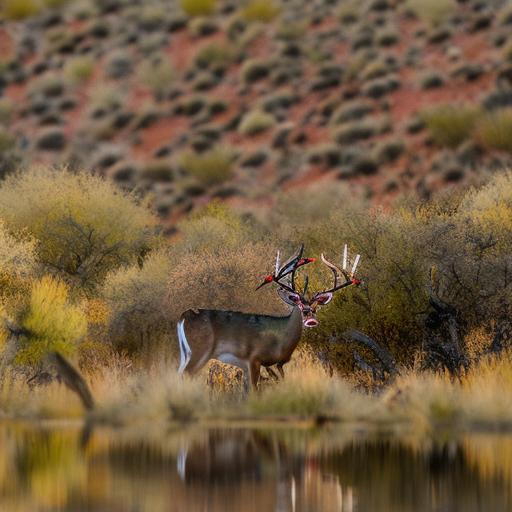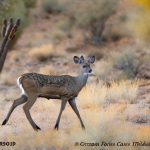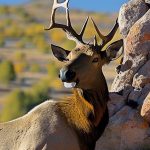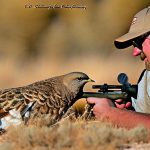Your cart is currently empty!

coues deer hunts

Coues deer hunting is a popular and thrilling activity that attracts hunters from all over the world. Named after the renowned naturalist Elliott Coues, these deer are found in the southwestern United States and northern Mexico. What sets Coues deer hunting apart from other types of deer hunting is the challenging terrain and elusive nature of these animals. They are known for their exceptional eyesight and ability to blend into their surroundings, making them a formidable opponent for any hunter.
My personal experience with Coues deer hunting was both exhilarating and humbling. I had heard stories of the difficulty involved in hunting these elusive creatures, but nothing could have prepared me for the reality. The first time I set foot in their habitat, I was struck by the beauty of the landscape and the sense of adventure that awaited me. As I embarked on my hunt, I quickly realized that patience and persistence were key. After days of tracking and stalking, I finally had my chance to take a shot. The adrenaline rush that followed was indescribable, and I felt a deep sense of respect for these magnificent animals.
Key Takeaways
- Coues deer hunting is a challenging and rewarding experience for hunters.
- Coues deer are found in the southwestern United States and Mexico, in mountainous and desert regions.
- The best time to hunt Coues deer is during the rut in November and December, or during the winter months when they are more active.
- Choosing the right gear, including a quality rifle and optics, is essential for a successful hunt.
- Spotting and stalking Coues deer requires patience, stealth, and knowledge of their behavior and habitat.
The Habitat and Distribution of Coues Deer
Coues deer are primarily found in the mountainous regions of Arizona, New Mexico, and Mexico. They inhabit a variety of habitats, including desert scrublands, oak woodlands, and pine forests. These deer are well adapted to their environment, with their small size and light-colored coat allowing them to blend seamlessly into their surroundings.
The distribution of Coues deer is influenced by several factors, including food availability, water sources, and predator presence. They are often found in areas with a mix of vegetation types, as this provides them with a diverse range of food sources. Additionally, they tend to prefer areas with access to water, as this is essential for their survival.
The Best Time of Year for Coues Deer Hunting
The best time of year for Coues deer hunting depends on several factors, including the hunting season, weather conditions, and the behavior of the deer. In general, the fall and winter months are considered prime hunting seasons for Coues deer. During this time, the deer are more active and are often found in lower elevations, making them more accessible to hunters.
Another important consideration is the rutting season, which typically occurs in November and December. This is when the bucks are most active and aggressive, making it an ideal time for hunters to target them. However, it’s important to note that hunting during the rut can be challenging, as the deer are more alert and cautious.
Choosing the Right Gear for a Successful Coues Deer Hunt
Choosing the right gear is crucial for a successful Coues deer hunt. Here are some essential items that every hunter should consider:
1. Rifle: A high-quality rifle with a flat trajectory and sufficient stopping power is essential for taking down a Coues deer. It’s important to choose a rifle that you are comfortable with and that suits your shooting style.
2. Optics: Good optics are essential for spotting Coues deer in their natural habitat. A high-quality pair of binoculars or a spotting scope can make all the difference in locating these elusive animals.
3. Clothing: Camouflage clothing that matches the natural surroundings is crucial for blending in and remaining undetected by Coues deer. Additionally, layering your clothing can help you stay comfortable in changing weather conditions.
4. Backpack: A sturdy backpack is essential for carrying your gear, water, and other essentials during a hunt. Look for one with multiple compartments and adjustable straps for maximum comfort.
5. Calls and Scents: Using calls and scents can be effective in attracting Coues deer during the rutting season. Experiment with different calls and scents to see what works best in your hunting area.
Tips for Spotting and Stalking Coues Deer
Spotting and stalking Coues deer requires a combination of patience, skill, and knowledge of their behavior. Here are some tips to help you improve your chances of success:
1. Glassing: Spend time glassing the area with your binoculars or spotting scope. Look for movement, flickering ears, or any other signs of deer activity. Pay attention to areas with good cover and food sources.
2. Move Slowly: Coues deer have excellent eyesight and can detect even the slightest movement. Move slowly and deliberately, taking care to avoid sudden movements that could alert the deer to your presence.
3. Use the Terrain to Your Advantage: Take advantage of natural features such as hills, trees, and rocks to conceal your movements. Use the terrain to get closer to the deer without being detected.
4. Be Patient: Coues deer are known for their cautious nature and will often freeze or bed down when they sense danger. Be patient and wait for the deer to relax before making your move.
5. Practice Shooting Positions: Coues deer hunting often involves shooting from various positions, including kneeling, sitting, or shooting offhand. Practice shooting from different positions to improve your accuracy in the field.
The Importance of Scouting for Coues Deer
Scouting is crucial for a successful Coues deer hunt. By familiarizing yourself with the area and the behavior of the deer, you can increase your chances of locating and harvesting a buck. Here are some tips for effective scouting:
1. Study Maps: Start by studying maps of the area you plan to hunt. Look for areas with good cover, water sources, and food availability. Pay attention to topographical features that could influence deer movement.
2. Look for Sign: Once you’re in the field, look for signs of deer activity such as tracks, rubs, scrapes, and droppings. These can give you valuable insights into the movement patterns of the deer.
3. Use Trail Cameras: Setting up trail cameras in strategic locations can provide you with valuable information about the deer in the area. Check the cameras regularly to see what deer are frequenting the area and at what times.
4. Glassing: Spend time glassing the area from vantage points to observe deer movement. Look for well-used trails, feeding areas, and bedding sites.
5. Talk to Locals: Local hunters and landowners can provide valuable insights into the behavior and movement patterns of Coues deer in the area. Strike up conversations with locals to gather information that can help you plan your hunt.
Hunting Techniques for Coues Deer
There are several hunting techniques that can be effective for Coues deer hunting. Here are a few popular ones:
1. Spot and Stalk: This technique involves glassing an area from a distance, spotting a deer, and then stalking within shooting range. It requires patience, stealth, and good optics.
2. Still Hunting: Still hunting involves moving slowly and quietly through the woods, stopping frequently to glass for deer activity. This technique is effective in areas with dense cover where deer are likely to bed down.
3. Tree Stand Hunting: Setting up a tree stand in a strategic location can provide an elevated vantage point and increase your chances of spotting deer. This technique is particularly effective during the rutting season when bucks are more active.
4. Rattling and Calling: During the rutting season, using rattling antlers or calls can be effective in attracting bucks. Mimicking the sounds of two bucks fighting or a doe in estrus can draw in curious bucks looking for a fight or a mate.
5. Ambush Hunting: Setting up an ambush near a well-used trail or feeding area can be an effective way to intercept Coues deer. This technique requires careful planning and knowledge of deer movement patterns.
Field Dressing and Processing Coues Deer
Field dressing and processing a Coues deer properly is essential for preserving the meat and avoiding waste. Here is a step-by-step guide to field dressing a Coues deer:
1. Tag the Animal: Before you begin field dressing, make sure to tag the animal as required by local regulations.
2. Remove the Internal Organs: Start by making an incision from the base of the sternum to the anus. Be careful not to puncture any organs. Reach into the chest cavity and cut through the diaphragm to expose the organs. Carefully remove the heart, lungs, liver, and other organs.
3. Remove the Hide: Make a circular cut around the anus and continue up towards the base of the tail. Make a shallow cut around each leg just above the knee joint. Use a sharp knife to carefully separate the hide from the meat, working your way towards the head.
4. Quarter the Animal: Once the hide is removed, quarter the animal by cutting through the joints at the knees and shoulders. This will make it easier to transport and process the meat.
5. Cool and Clean: Rinse the quarters with clean water to remove any dirt or debris. Hang them in a cool, shaded area to allow them to cool down. It’s important to cool the meat as quickly as possible to prevent spoilage.
When it comes to processing Coues deer meat, there are several options depending on your preferences. Some hunters prefer to process their own meat, while others choose to take it to a professional butcher. If you decide to process it yourself, make sure you have the necessary equipment and knowledge to do so safely.
The Ethics of Coues Deer Hunting
Ethical considerations are an important aspect of any hunting activity, including Coues deer hunting. It’s important to hunt responsibly and ethically to ensure the long-term sustainability of the species and their habitat. Here are some ethical guidelines to keep in mind:
1. Know and Follow the Laws: Familiarize yourself with the hunting regulations and laws in your area. Make sure you have the necessary licenses and tags, and abide by the bag limits and hunting seasons.
2. Respect the Animal: Treat the animal with respect and gratitude for providing sustenance. Make every effort to ensure a quick and humane kill, and minimize suffering.
3. Practice Fair Chase: Engage in fair chase hunting, which means giving the animal a fair chance to escape. Avoid using illegal or unethical methods such as baiting or spotlighting.
4. Use All Parts of the Animal: Make every effort to use all parts of the animal, including the meat, hide, antlers, and bones. This demonstrates respect for the animal and minimizes waste.
5. Leave No Trace: Practice Leave No Trace principles by minimizing your impact on the environment. Pack out all trash and dispose of it properly, and avoid damaging vegetation or disturbing wildlife.
Conservation Efforts for Coues Deer and their Habitat
Conservation efforts are crucial for protecting Coues deer and their habitat. Several organizations and agencies are working to conserve these deer and their ecosystems. Hunters can contribute to conservation efforts in several ways:
1. Support Conservation Organizations: Consider joining or supporting organizations that work to conserve wildlife habitats, such as the National Wildlife Federation or local conservation groups.
2. Volunteer for Habitat Restoration Projects: Many organizations conduct habitat restoration projects that involve planting native vegetation, removing invasive species, or improving water sources. Volunteer your time to help with these projects.
3. Practice Responsible Land Stewardship: If you own or lease land where Coues deer are found, practice responsible land stewardship by maintaining healthy habitats, providing water sources, and managing predators.
4. Report Poaching or Illegal Activities: If you witness poaching or other illegal activities that threaten Coues deer or their habitat, report them to the appropriate authorities.
5. Educate Others: Share your knowledge and passion for Coues deer hunting with others. Educate fellow hunters and non-hunters about the importance of conservation and responsible hunting practices.
Coues deer hunting is a thrilling and challenging pursuit that offers hunters a unique experience in the rugged landscapes of the southwestern United States and northern Mexico. By understanding the habitat and behavior of Coues deer, choosing the right gear, and employing effective hunting techniques, hunters can increase their chances of success. It’s important to approach Coues deer hunting with respect for the animal, practicing ethical hunting methods and contributing to conservation efforts. So, grab your gear, head out into the wilderness, and embark on an unforgettable Coues deer hunting adventure.
If you’re interested in coues deer hunts, you might also want to check out this informative article on how to hunt pheasant without a dog. It provides valuable tips and techniques for those who prefer to hunt these birds without the assistance of a canine companion. Whether you’re a seasoned hunter or just starting out, this article offers practical advice that can enhance your hunting experience. So, if you’re looking to expand your hunting skills beyond coues deer, give it a read! (source)
FAQs
What is a Coues deer?
Coues deer is a subspecies of the white-tailed deer found in Arizona, New Mexico, and Mexico. They are smaller in size and have a grayish-brown coat with a white belly.
What is a Coues deer hunt?
A Coues deer hunt is a type of hunting expedition that involves pursuing and harvesting Coues deer. It is a popular activity among hunters and outdoor enthusiasts in the southwestern United States.
When is the best time for a Coues deer hunt?
The best time for a Coues deer hunt is during the rutting season, which typically occurs from late December to early February. However, the hunting season for Coues deer varies depending on the state and region.
What equipment do I need for a Coues deer hunt?
The equipment needed for a Coues deer hunt includes a hunting rifle, ammunition, binoculars, a hunting knife, and appropriate clothing and footwear. It is also recommended to bring a hunting guide or experienced hunter to assist with the hunt.
Do I need a license to hunt Coues deer?
Yes, a hunting license is required to hunt Coues deer. The specific requirements and regulations vary depending on the state and region where the hunt takes place.
What is the success rate for a Coues deer hunt?
The success rate for a Coues deer hunt varies depending on several factors, including the hunting location, hunting experience, and weather conditions. However, the success rate is generally lower compared to other types of deer hunts due to the elusive nature of Coues deer.

Herb has been a longtime lover of the outdoors. Whether it be hunting, camping, fishing or just getting outside to reset. Proud father and animal lover. Bourbon anyone?

by
Tags:
Comments

Categories
- Big Game Hunting (301)
- Deer (202)
- Reviews (3)
- Shooting (16)
- Slingshot (1)
- Small Game Hunting (42)
- Upland Hunting (126)
- Waterfowl Hunting (3)





Leave a Reply